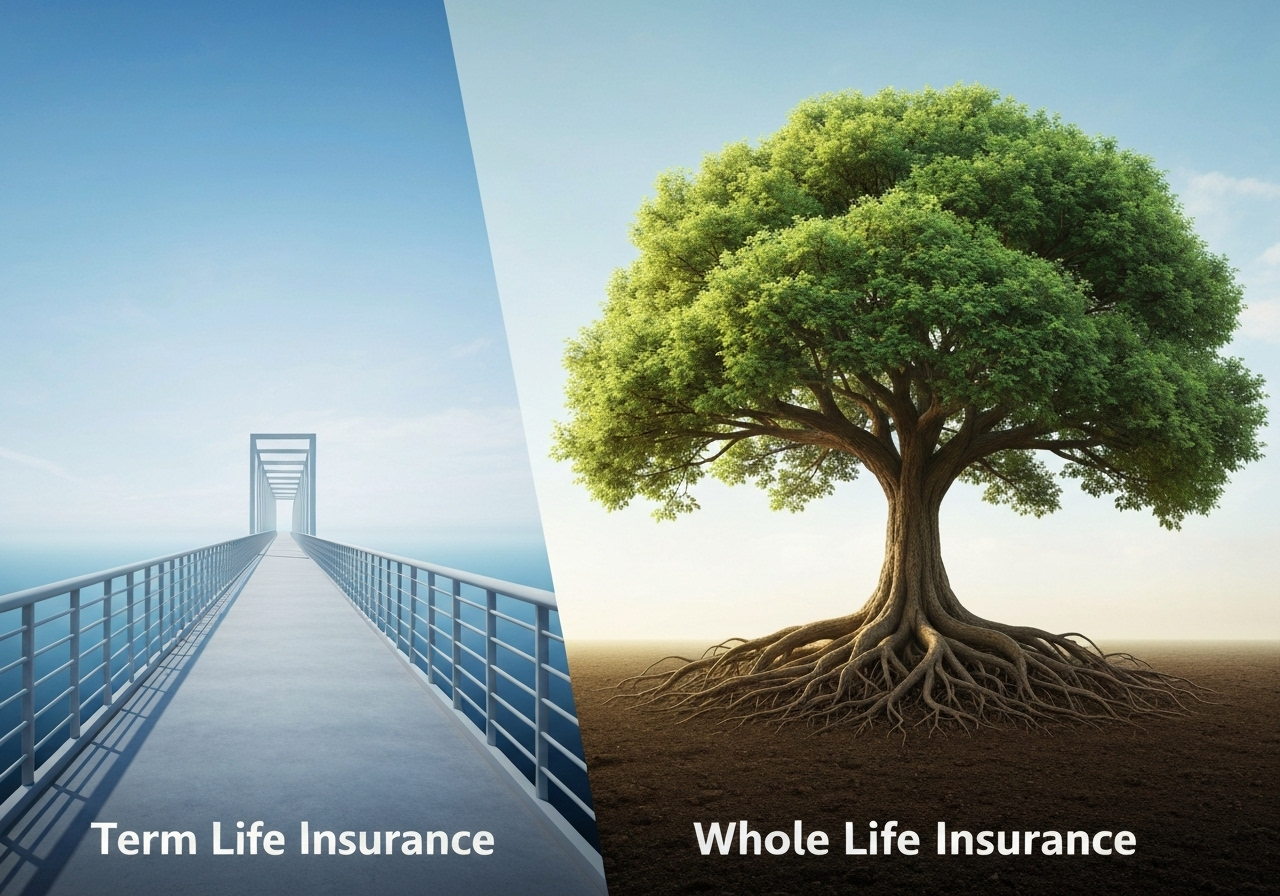Introduction: Navigating Your Life Insurance Options
Understanding life insurance is a crucial step in securing your family’s financial future. It acts as a safety net, providing a tax-free payout to your beneficiaries when you pass away, helping them manage expenses like mortgages, daily living costs, and education. A significant decision many individuals face is choosing between Term vs. Whole Life Insurance, two primary types each offering distinct advantages tailored to different financial needs and life stages.
What is Term Life Insurance? Understanding Temporary Coverage
Term life insurance is known for its simplicity and affordability. It provides coverage for a specific period, or “term,” which typically ranges from 10 to 30 years. Should the policyholder pass away within this defined term, beneficiaries receive the death benefit. However, if you outlive the term, the policy expires without a payout, unless it is renewed (often at a higher premium) or converted to a permanent policy.
Key features of term life insurance include:
- Fixed Premiums: For most level term policies, premiums remain consistent throughout the chosen term, making budgeting straightforward.
- Defined Coverage Period: You select a term that aligns with specific financial obligations, such as the duration of a mortgage or until children achieve financial independence.
- No Cash Value: Unlike whole life, term life insurance does not accumulate a cash value component. This absence of a savings feature contributes to its lower cost compared to permanent life insurance.
This policy type is often ideal for those who need substantial coverage for a specific period at the most budget-friendly rates. For example, a young family might opt for a 20-year term policy to cover the years their children are growing up and dependent.
Benefits and Limitations of Term Life Policies
Term life insurance offers several compelling benefits, primarily its cost-effectiveness and straightforward nature. It allows individuals to secure a significant death benefit for a relatively low premium, especially when younger and healthier. This makes it an excellent choice for covering high-impact, temporary financial responsibilities. For more insights on how term life insurance can meet specific needs, consider exploring resources on life insurance needs at different stages.
However, term life policies also have limitations:
- Expiration: Coverage ends once the term concludes, potentially leaving individuals without insurance later in life when health may decline and new policies become more expensive.
- No Cash Value Accumulation: The policy does not build a cash value, meaning there’s no component to borrow against or withdraw from during your lifetime.
- Renewability Costs: Renewing a term policy after its initial period often results in significantly higher premiums due to increased age and potential health changes.
Understanding Whole Life Insurance: Lifetime Protection with Cash Value
Whole life insurance is a type of permanent life insurance designed to provide coverage for your entire life, as long as premiums are paid. It’s often considered a more comprehensive financial tool due to features beyond a death benefit, offering both protection and a unique savings component.
Key aspects of whole life insurance include:
- Lifelong Protection: The policy remains in force for your entire life, guaranteeing a death benefit will eventually be paid to your beneficiaries, regardless of when you pass away.
- Guaranteed Cash Value Growth: A portion of each premium payment contributes to a cash value component, which grows over time at a guaranteed rate. This cash value is tax-deferred and can be accessed during your lifetime.
- Fixed Premiums: Once established, premiums for a whole life policy typically remain level and will not increase, providing predictability in your long-term financial planning.
The cash value feature is a significant differentiator. Policyholders can borrow against this accumulated cash value or make withdrawals. These funds can be used for various purposes, such as supplemental retirement income, funding a child’s education, or covering unexpected expenses. However, loans and withdrawals can reduce the death benefit if not repaid. For a deeper dive into this aspect, our overall guide to whole life insurance offers valuable insights.
Exploring the Advantages and Considerations of Whole Life Coverage
Whole life insurance offers unique advantages, particularly for those seeking long-term financial stability and a built-in savings component. Its permanence ensures that loved ones will receive a death benefit regardless of when the policyholder passes, which is invaluable for covering final expenses or leaving a legacy. The guaranteed cash value growth also provides a predictable, tax-deferred asset that can be accessed for various living needs, such as a down payment on a home or supplemental retirement income, as discussed in detail on integrating life insurance into your financial plan.
However, there are important considerations:
- Higher Premiums: Whole life insurance is significantly more expensive than term life insurance, reflecting its lifelong coverage and cash value accumulation.
- Less Investment Flexibility: While it offers cash value growth, the returns are typically modest and may not keep pace with market-driven investments.
- Complexity: The structure of whole life policies, with their cash value and dividend options, can be more complex to understand compared to the straightforward nature of term insurance.
Term vs. Whole Life Insurance: Which Path is Right for You?
The decision between Term vs. Whole Life Insurance is a personal one, depending on your unique financial situation, goals, and risk tolerance. There’s no universal “best” option; rather, it’s about finding the policy that aligns perfectly with your specific circumstances. A good first step is to consider the duration of your need for coverage.
To help clarify the fundamental differences, here’s a comparative overview:
| Feature | Term Life Insurance | Whole Life Insurance |
|---|---|---|
| Coverage Duration | Specific period (e.g., 10, 20, 30 years) | Lifetime (as long as premiums are paid) |
| Cost (Premiums) | Generally lower, more affordable | Significantly higher than term life |
| Cash Value Accumulation | No cash value | Builds cash value at a guaranteed rate |
| Access to Funds | No (unless a special rider is purchased) | Yes, through loans or withdrawals against cash value |
| Death Benefit Guarantee | Guaranteed if death occurs within the term | Guaranteed regardless of when death occurs |
| Complexity | Simpler, straightforward | More complex due to cash value and other features |
Factors to Consider When Choosing Your Policy
Choosing the right life insurance policy requires a careful assessment of several factors:
-
Your Financial Obligations:
If you have temporary financial responsibilities like a mortgage, car loans, or young children, term life insurance might be more suitable. It provides substantial coverage during the years you need it most. For lifelong obligations, such as providing for a spouse or leaving an inheritance, whole life insurance offers permanent protection.
-
Your Budget:
Term life insurance typically has lower premiums, making it a more budget-friendly option for securing significant coverage. Whole life insurance, with its lifelong coverage and cash value component, comes with higher premiums. Ensure you can comfortably afford the premiums for your chosen policy type over the long term.
-
Need for Cash Value:
Do you want your policy to include a savings component that you can access during your lifetime? If so, whole life insurance with its guaranteed cash value growth could be a valuable asset. If your primary goal is a death benefit without a savings feature, term life is simpler and more direct.
-
Long-Term Goals:
Consider your long-term financial and estate planning goals. Whole life can be a strategic tool for wealth transfer and ensuring funds for final expenses. Term life aligns well with specific, time-bound goals like ensuring your children’s education is funded.
Sometimes, a combination of both can be the most effective strategy—often referred to as “laddering.” This involves purchasing a base whole life policy for lifelong needs and adding term policies for specific, temporary obligations. This allows for both permanent protection and higher coverage during critical periods.
Considering a Term to Whole Life Conversion
Many term life insurance policies offer a “convertibility” feature, allowing policyholders to convert their term policy into a permanent life insurance policy (such as whole life) without needing a new medical exam. This can be a valuable option as your life circumstances and financial needs evolve.
Reasons to consider converting a term policy:
- Changing Needs: As temporary financial obligations diminish (e.g., mortgage paid off, children grown), you might desire lifelong coverage to cover final expenses or leave a legacy.
- Health Changes: If your health has declined since you initially purchased your term policy, conversion allows you to secure permanent coverage at standard rates, avoiding higher premiums or even uninsurability if you were to apply for a new policy.
- Desire for Cash Value: Converting to a whole life policy introduces a cash value component that grows over time, providing a living benefit you can access.
It’s important to understand that converting to a whole life policy will result in higher premiums than your original term policy, reflecting the increased benefits and lifelong coverage. Reviewing the terms of your current policy and consulting with an insurance professional is crucial before making a conversion decision.
Your Trusted Partner: Expert Guidance from Beach Insurance LLC
Choosing the right life insurance policy is a significant financial decision that should not be taken lightly. It involves a careful assessment of your unique family situation, current financial obligations, long-term goals, and budget. While understanding the differences between Term vs. Whole Life Insurance is a crucial first step, applying this knowledge to your specific circumstances can be challenging.
At Beach Insurance LLC, we understand that every individual and family has unique needs. Our experienced professionals are dedicated to providing personalized guidance, helping you cut through the complexities and find the life insurance solution that offers the best protection for your loved ones. We are here to help you navigate your options, answer your questions, and ensure you make an informed decision that brings lasting peace of mind. We invite you to explore more about securing your financial future through comprehensive planning on our site, such as in our article Secure Your Future: Understanding the Key Types of Life Insurance in 2025.
Securing Your Future: Making an Informed Decision
Ultimately, the “best” life insurance policy is the one that provides the most appropriate coverage for your specific needs and financial situation. Whether you choose the cost-effectiveness and targeted coverage of term life or the lifelong protection and cash value growth of whole life, the right choice provides invaluable peace of mind. Consider your age, health, financial dependents, existing debts, long-term financial goals, and budget. Regularly reviewing your policy as life changes—such as getting married, having children, buying a home, or nearing retirement—is crucial to ensure your coverage remains adequate. Partnering with a knowledgeable advisor, like those at Beach Insurance LLC, can provide invaluable insight and support throughout this important decision-making process.
Ready to discuss your life insurance options? Visit our Contact Us page today!






